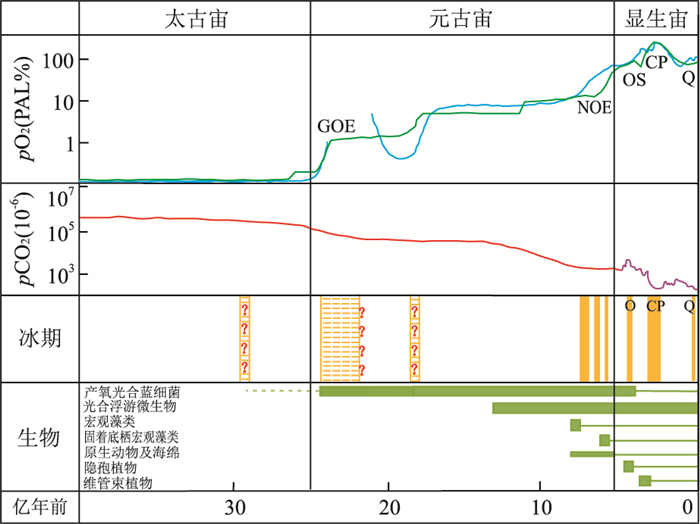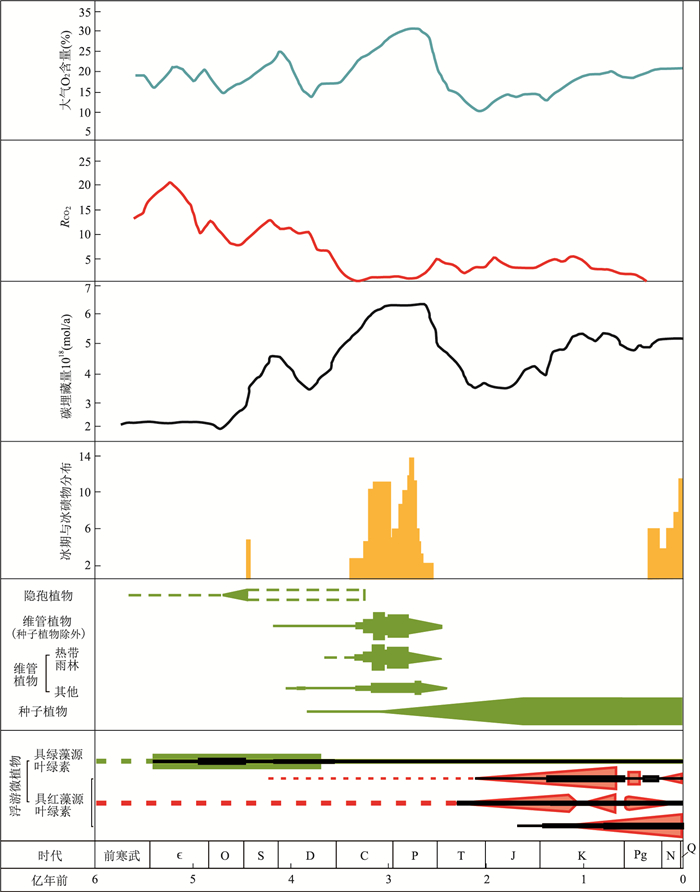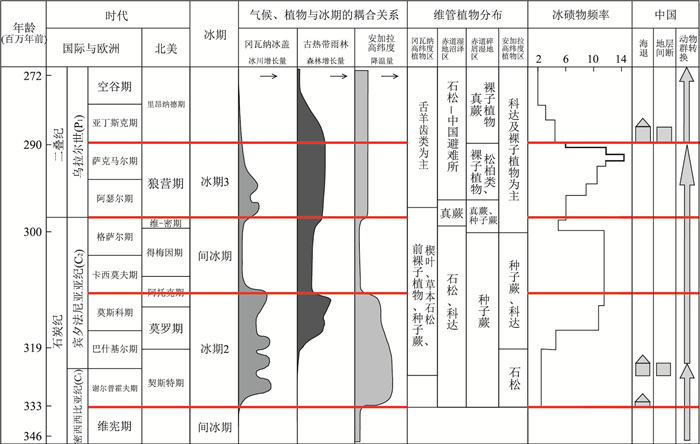Biotic Influence on the Formation of Icehouse Climates in Geologic History
-
摘要: 在地质历史时期的碳循环中,生物的作用很大.生物产氧光合作用消耗CO2而产生有机质与O2;有机质及生物成因碳酸盐岩埋藏又进一步固定CO2并减少O2消耗,所以生物产氧光合事件与冰期、成(增)氧期应存在因果关系.论述了5次事件,分别是:与产氧光合蓝细菌有关的古元古代初期大氧化事件(Early Proterozoic great oxygenation event,GOE)、与真核生物辐射事件有关的新元古代大成氧事件(Neoproterozoic oxidation event,NOE)、与早期陆生植物繁盛事件有关的晚奥陶世增氧和冰期事件、与维管植物繁盛事件有关的石炭纪-二叠纪增氧和冰期事件及与被子植物和浮游微植物繁盛有关的第四纪冰期事件.结果表明,5次成氧事件和冰期与生物事件有因果关系,主要表现为,都有冰期和成氧事件共存或相继出现的证据,反映大气CO2降低和O2增加同时或相继发生,而这只能由生物的光合作用及其产物的埋藏造成.这说明生物不仅仅是适应于环境,它也对环境产生重大影响,生物与环境的这种相互作用在漫长的地质历史中表现为协同演化.但是早期生物事件并不立刻产生成氧或冰期等环境效应,这种效应开始是微量的,逐渐积累,达到阈值后才发生质变,所以在时间上是滞后的.随着生物多样性和丰度的增加,这种效应越来越大,速率越来越快,滞后性逐渐减弱,耦合性日渐明显.生物与地球环境之间的相互作用构成了生物与地球系统的自我调节,使地球与其他星球不同,其表层始终保持在生命宜居的环境范围内.今天人类更要理智地、科学地善待地球,避免对地球造成重大的负面影响.Abstract: The impact of organisms on the carbon cycle since Proterozoic should not be underestimated. Oxygenic photosynthesis of organisms produces organic matter and O2 while consuming CO2. Burying of organic matter and biogenic carbonates further sequestrates CO2 and decreases the consumption of O2. It is thus reasonable that causal relationship should exist among oxygenic photosynthesis of organisms, icehouse climates and oxygenation events. In this paper, we discuss 5 events, namely, the Early Proterozoic great oxygenation event (GOE) in connection with oxygenic photosynthesis of cyanobacteria, the Neoproterozoic oxidation event (NOE) in connection with radiation of eukaryotes, the Late Ordovician oxygenic-icehouse event in connection with flourish of early land plants, the Carboniferous-Permian oxygenation icehouse event in connection with flourish of vascular plants, and the Quaternary icehouse event in connection with angiosperms and phytoplanktons. In these events, such causality is indicated by coexistences or successive appearances of icehouse climates and oxygenation events, reflecting atmospheric CO2 decreases and O2 increases, which are possible only through biogenic photosynthesis and successive burying of its products. Causal relationship among oxygenic photosynthesis of organisms, oxygenation and icehouse climate indicates the interaction between organisms and their environments. Organisms do not merely adapt to their environments, they also influence the environments. In the prolonged geologic history, such interaction formed co-evolution between the two. However, biotic oxygenation did not immediately produce oxygenic or icehouse effects in early geologic history. Such effects were minimal at first and accumulated gradually, and became efficient when reaching certain threshold, so usually delayed in time. Following the increase of biotic diversity, abundance and metabolic ability, its impact on environments became stronger, time-delay decreased and coupling increased. Such interaction between organism and environment forms the self-regulation between biosphere and earth system, which explains why, unlike other planets, the Earth's surface has been maintaining a habitable environment. The lesson for mankind is that we should treat the relationship scientifically, so as to avoid negative impact on our mother earth.
-
Key words:
- biology /
- oxygenation event /
- glacial period /
- deep-time climate /
- coevolution
-
图 2 地史时期大气O2和CO2浓度、冰期与生物演化事件的关系
4次成氧事件:GOE.大成氧事件(2 450~2 320 Ma);NOE.新元古成氧事件(800~550 Ma);OS.奥陶纪末成氧事件(445~400? Ma);CP.石炭纪-二叠纪成氧事件(340~240 Ma)(Kirschvink et al., 2000; Canfield, 2005; Och and Shields-Zhou, 2012; Lenton et al., 2012; 梅冥相,2016).PAL%.与当代大气水平之比; 蓝色线元古宙部分据Och and Shields-Zhou(2012),转录自Canfield(2005),显生宙部分据Berner(2006);绿线据Campbell and Allen(2008);CO2浓度:红色据Kasting(1987);紫线据Berner(2006);其纵坐标均转化为对数坐标,故与原图有异;5次冰期:太古宙及古元古代据Evans(2003); Kirschvink et al.(2000),与GOE对应的为Makganyene/Huronian冰期,其时代尚不确定,在其前后各有一次有疑问(带?号)的冰期;新元古代的冰期依次为Sturtian冰期(ca.720~660 Ma),Marinoan冰期(655~635 Ma),Gaskiers冰期(580 Ma),时代据Gradstein et al.(2012);显生宙冰期为奥陶纪-志留纪之交(OS),石炭纪-二叠纪(CP)及第四纪(Q),时代据Veizer et al.(2000); Isbell et al.(2003); Montanez et al.(2007);生物事件:元古宙生物据Knoll(2014); Maloof et al.(2010); Ye et al.(2015); Yuan et al.(2011);隐孢植物据Lenton et al.(2012, 2014);维管束植物据Cleal and Thomas(2005); Chaloner(2003).虚线表示不确定
Fig. 2. elationships among atmospheric pO2, pCO2, glaciations and biotic evolution events
图 3 显生宙O2、CO2、冰期与生物的关系
大气O2%据Berner(2006)(图 17);RCO2指某地质时期与近百万年(平均值)大气中CO2质量之比,据Berner(2006)(图 18);CO2曲线还可参阅IPCC(2007);碳埋藏量据Berner(2003);冰期与冰碛物频率据Gastaldo et al.(1996);植物据Lenton et al.(2012, 2016),Cleal and Thomas(2005);浮游微植物据Martin and Quigg(2013).其黑线代表丰度,红、绿色代表多样性
Fig. 3. Relationships among atmospheric pO2, pCO2, glaciations and evolution of organisms
图 4 石炭纪-二叠纪植物盛衰与冰期间冰期的耦合
气候、植物盛衰与冰期的耦合关系据Cleal and Thomas(2005);维管植物分布及冰碛物频率据Gastaldo et al.(1996);中国相应的海退、地层间断与海洋动物群转换据Wang et al.(2013);维-密期指维吉尔期-密苏里期
Fig. 4. The coupling relationships between the wax-wane of terrestrial plants and glacial-interglacial transitions in Carboniferous and Permian
-
Allison, C.W., Hilgert, J.W., 1986.Scale Microfossils from the Early Cambrian of Northwest Canada.Journal of Paleontology, 60(5):973-1015. https://doi.org/10.1017/s0022336000022538 Anbar, A.D., Duan, Y., Lyons, T.W., et al., 2007.A Whiff of Oxygen before the Great Oxidation Event? Science, 317(5846):1903-1906. https://doi.org/10.1126/science.1140325 Beerling, D.J., Woodward, F.I., 2003.Vegetation and the Terrestrial Carbon Cycle:Modelling the First 400 Million Years.Cambridge University Press, Cambridge, 405. Belcher, C.M., McElwain, J.C., 2008.Limits for Combustion in Low O2 Redefine Paleoatmospheric Predictions for the Mesozoic.Science, 321(5893):1197-1200. https://doi.org/10.1126/science.1160978 Bergman, N.M., 2004.Copse:A New Model of Biogeochemical Cycling over Phanerozoic Time.American Journal of Science, 304(5):397-437. https://doi.org/10.2475/ajs.304.5.397 Berner, R.A., 2003.The Long-Term Carbon Cycle, Fossil Fuels and Atmospheric Composition.Nature, 426(6964):323-326. https://doi.org/10.1038/nature02131 Berner, R.A., 2006.Geocarbsulf:A Combined Model for Phanerozoic Atmospheric O2 and CO2.Geochimica et Cosmochimica Acta, 70(23):5653-5664. https://doi.org/10.1016/j.gca.2005.11.032 Brocks, J.J., Jarrett, A.J.M., Sirantoine, E., et al., 2017.The Rise of Algae in Cryogenian Oceans and the Emergence of Animals.Nature, 548(7669):578-581. https://doi.org/10.1038/nature23457 Buick, R., 2008.When did Oxygenic Photosynthesis Evolve? Philosophical Transactions of the Royal Society B, 363:2731-2743. doi: 10.1098/rstb.2008.0041 Butterfield, N.J., 2000.Bangiomorpha Pubescensn.gen., N.sp.:Implications for the Evolution of Sex, Multicellularity, and the Mesoproterozoic/Neoproterozoic Radiation of Eukaryotes.Paleobiology, 26(3):386-404.https://doi.org/10.1666/0094-8373(2000)026<0386:bpngns>2.0.co;2 doi: 10.1666/0094-8373(2000)026<0386:bpngns>2.0.co;2 Butterfield, N.J., Knoll, A.H., Swett, K., 1994.Paleobiology of the Neoproterozoic Svanbergfjellet Formation, Spitsbergen.Lethaia, 27(1):76-76. https://doi.org/10.1111/j.1502-3931.1994.tb01558.x Campbell, I.H., Allen, C.M., 2008.Formation of Supercontinents Linked to Increases in Atmospheric Oxygen.Nature Geoscience, 1(8):554-558. https://doi.org/10.1038/ngeo259 Campbell, I.H., Squire, R.J., 2010.The Mountains that Triggered the Late Neoproterozoic Increase in Oxygen:The Second Great Oxidation Event.Geochimica et Cosmochimica Acta, 74(15):4187-4206. https://doi.org/10.1016/j.gca.2010.04.064 Canfield, D.E., 1998.A New Model for Proterozoic Ocean Chemistry.Nature, 396(6710):450-453. doi: 10.1038/24839 Canfield, D.E., 2005.The Early History of Atmospheric Oxygen:Homage to Robert M.Garrels.Annual Review of Earth and Planetary Sciences, 33(1):1-36. https://doi.org/10.1146/annurev.earth.33.092203.122711 Canfield, D.E., Teske, A., 1996.Late Proterozoic Rise in Atmospheric Oxygen Concentration Inferred from Phylogenetic and Sulphur-Isotope Studies.Nature, 382(6587):127-132. https://doi.org/10.1038/382127a0 Cerling, T.E., Ehleringer, J.R., Harris, J.M., 1998.Carbon Dioxide Starvation, the Development of C4 Ecosystems, and Mammalian Evolution.Philosophical Transactions of the Royal Society B:Biological Sciences, 353(1365):159-171. https://doi.org/10.1098/rstb.1998.0198 Chaloner, W.G., 2003.The Role of Carbon Dioxide in Plant Evolution.Evolution on Planet Earth, 65-83. Chen, X., Ling, H.F., Vance, D., et al., 2015.Rise to Modern Levels of Ocean Oxygenation Coincided with the Cambrian Radiation of Animals.Nature Communications, 6:7142. https://doi.org/10.1038/ncomms8142 Chinese Academy of Sciences, 2015.Developling Stratiges of Disciplines in China:Geobiology.Science Press, Beijing, 368 (in Chinese). Claussen, M., Fohlmeister, J., Ganopolski, A., et al., 2006.Vegetation Dynamics Amplifies Precessional Forcing.Geophysical Research Letters, 33:L09709. https://doi.org/10.1029/2006GL026111 Cleal, C.J., Thomas, B.A., 2005.Palaeozoic Tropical Rainforests and Their Effect on Global Climates:Is the Past the Key to the Present? Geobiology, 3(1):13-31. https://doi.org/10.1111/j.1472-4669.2005.00043.x Cohen, P.A., Knoll, A.H., 2012.Scale Microfossils from the Mid-Neoproterozoic Fifteen Mile Group, Yukon Territory.Journal of Paleontology, 86(5):775-800. https://doi.org/10.1666/11-138.1 Corsetti, F.A., Olcott, A.N., Bakermans, C., 2006.The Biotic Response to Neoproterozoic Snowball Earth.Palaeogeography, Palaeoclimatology, Palaeoecology, 232(2-4):114-130. https://doi.org/10.1016/j.palaeo.2005.10.030 Costanza, R., d'Arge, R., de Groot, R., et al., 1997.The Value of the World's Ecosystem Services and Natural Capital.Nature, 387(6630):253-260. https://doi.org/10.1038/387253a0 Coxall, H.K., Pearson, P.N., 2007.The Eocene-Oligocene Transition.In: Williams, M., Haywood, A.M., Gregory, F.J., eds., Deep-Time Perspectives on Climate Change: Marrying the Signal from Computer Models and Biological Proxies.The Micropalaeontological Society, Special Publications.The Geological Society, London, 351-387. Crucifix, M., Hewitt, C.D., 2005.Impact of Vegetation Changes on the Dynamics of the Atmosphere at the Last Glacial Maximum.Climate Dynamics, 25:447-459. https://doi.org/10.1007/s00382-005-0013-8 Dahl, T.W., Hammarlund, E.U., Anbar, A.D., et al., 2010.Devonian Rise in Atmospheric Oxygen Correlated to the Radiations of Terrestrial Plants and Large Predatory Fish.Proceedings of the National Academy of Sciences, 107(42):17911-17915. https://doi.org/10.1073/pnas.1011287107 Edwards, D., Morris, J.L., Richardson, J.B., et al., 2014.Cryptospores and Cryptophytes Reveal Hidden Diversity in Early Land Floras.New Phytologist, 202(1):50-78. https://doi.org/10.1111/nph.12645 Evans, D.A.D., 2003.A Fundamental Precambrian-Phanerozoic Shift in Earth's Glacial Style? Tectonophysics, 375(1-4):353-385. https://doi.org/10.1016/s0040-1951(03)00345-7 Falkowski, P.G., Katz, M.E., Knoll, A.H., et al., 2004.The Evolution of Modern Eukaryotic Phytoplankton.Science, 305(5682):354-360. doi: 10.1126/science.1095964 Falkowski, P.G., Fenchel, T., Delong, E.F., 2008.The Microbial Engines that Drive Earth's Biogeochemical Cycles.Science, 320(5879):1034-1039. https://doi.org/10.1126/science.1153213 Falkowski, P.G., Katz, M.E., Milligan, A.J., et al., 2005.The Rise of Oxygen over the Past 205 Million Years and the Evolution of Large Placental Mammals.Science, 309(5744):2202-2204. https://doi.org/10.1126/science.1116047 Fielding, C.R., Frank, T.D., Isbell, J.L., 2008.The Late Paleozoic Ice Age-A Review of Current Understanding and Synthesis of Global Climate Patterns.In: Fielding, C.R., Frank, T.D., Isbell, J.L., eds., Resolving the Late Paleozoic Ice Age in Time and Space.Geological Society of America, Special Papers, 441: 343-354. Friis, E.M., 1985.Structure and Function in Late Cretaceous Angiosperm Flowers.Kongl.Danske Vidensk Selskab Biol.Skrifter, 25:1-33. http://agris.fao.org/agris-search/search.do?recordID=US201301463173&sourceQuery=&query=&sortField=&sortOrder=&agrovocString=&advQuery=¢erString= Gallimore, R.G., Kutzbach, J.E., 1996.Role of Orbitally Induced Changes in Tundra Area in the Onset of Glaciation.Nature, 381(6582):503-505. https://doi.org/10.1038/381503a0 Gao, L.Z., Yin, C.Y., Xing, Y.S., 1999.Neoproterozoic Micropalaeophyta and Sequence Stratigraphy.Professional Papers of Stratigraphy and Palaeontology, 27:28-36 (in Chinese with English abstract). http://www.wanfangdata.com.cn/details/detail.do?_type=perio&id=QK199901376822 Gastaldo, R., DiMichele, W., Pfefferkorn, H.W., 1996.Out of Ice House into the Green House:A Late Paleozoic Analogue for the Modern Global Vegetational Changes.GSA Today, 6(10):1-7. Gibbs, M.T., Barron, E.J., Kump, L.R., 1997.An Atmospheric pCO2 Threshold for Glaciation in the Late Ordovician.Geology, 25(5):447.https://doi.org/10.1130/0091-7613(1997)025<0447:aapctf>2.3.co;2 doi: 10.1130/0091-7613(1997)025<0447:aapctf>2.3.co;2 Gough, D.O., 1981.Solar Interior Structure and Luminosity Variations.Solar Physics, 74(1):21-34. https://doi.org/10.1007/bf00151270 Gradstein, F.M., Ogg, J.G., Schmitz, M.D., et al., 2012.The Geologic Time Scale 2012.Elsevier, Amsterdam, 1144. Graham, L.E., Cook, M.E., Wilcox, L.W., et al., 2013.Resistance of Filamentous Chlorophycean, Ulvophycean, and Xanthophycean Algae to Acetolysis:Testing Proterozoic and Paleozoic Microfossil Attributions.International Journal of Plant Sciences, 174(6):947-957. https://doi.org/10.1086/670591 Herrmann, A.D., Patzkowsky, M.E., Pollard, D., 2003.Obliquity Forcing with 8-12 Times Preindustrial Levels of Atmospheric pCO2 during the Late Ordovician Glaciation.Geology, 31(6):485.https://doi.org/10.1130/0091-7613(2003)031<0485:ofwtpl>2.0.co;2 doi: 10.1130/0091-7613(2003)031<0485:ofwtpl>2.0.co;2 Holland, H.D., 2002.Volcanic Gases, Black Smokers, and the Great Oxidation Event.Geochimica et Cosmochimica Acta, 66(21):3811-3826. https://doi.org/10.1016/s0016-7037(02)00950-x House, J.I., Colin Prentice, I., Le Quere, C., 2002.Maximum Impacts of Future Reforestation or Deforestation on Atmospheric CO2.Global Change Biology, 8(11):1047-1052. https://doi.org/10.1046/j.1365-2486.2002.00536.x IPCC, 2007.Climate Change 2007: The Physical Science Basis: Contribution of Working Group 1 to the Fourth Assessment Report of IPCC.IPCC WGI Fourth Assessment Report, 18. Isbell, J.L., Miller, M.F., Wolfe, K.L., et al., 2003.Timing of Late Paleozoic Glaciation in Gondwana: Was Glaciation Responsible for the Development of Northern Hemisphere Cyclothems?In: Chan, M.A., Archer, A.W., eds., Extreme Depositional Environments: Mega End Members in Geologic Time.Geological Society of America, Special Papers, 370: 5-24. Jahn, A., Claussen, M., Ganopolski, A., et al., 2005.Quantifying the Effect of Vegetation Dynamics on the Climate of the Last Glacial Maximum.Climate of the Past Discussions, 1(1):1-7. https://doi.org/10.5194/cpd-1-1-2005 Jiao, N.Z., Azam, F., 2011.Microbial Carbon Pump and Its Significance for Carbon Sequestration in the Ocean.In: Jiao, N.Z., Azam, F., Sanders, S., eds., Microbial Carbon Pump in the Ocean (Supplement to Science).Science/AAAS.Washington, D.C., 43-45. Microbial Carbon Pump and Its Significance for Carbon Sequestration in the Ocean. Kasting, J.F., 1987.Theoretical Constraints on Oxygen and Carbon Dioxide Concentrations in the Precambrian Atmosphere.Precambrian Research, 34(3-4):205-229. https://doi.org/10.1016/0301-9268(87)90001-5 Kenrick, P., Wellman, C.H., Schneider, H., et al., 2012.A Timeline for Terrestrialization:Consequences for the Carbon Cycle in the Palaeozoic.Philosophical Transactions of the Royal Society B:Biological Sciences, 367(1588):519-536. https://doi.org/10.1098/rstb.2011.0271 Kirschvink, J., 1992.Late Proterozoic Low-Latitude Global Glaciation: The Snowball Earth.In: Schopf, J.W., Klein, C., eds., The Proterozoic Biosphere.Cambridge University Press, New York, 51-52. Kirschvink, J.L., Gaidos, E.J., Bertani, L.E., et al., 2000.Paleoproterozoic Snowball Earth:Extreme Climatic and Geochemical Global Change and Its Biological Consequences.Proceedings of the National Academy of Sciences, 97(4):1400-1405. https://doi.org/10.1073/pnas.97.4.1400 Knoll, A.H., 2003.The Geological Consequences of Evolution.Geobiology, 1(1):3-14. https://doi.org/10.1046/j.1472-4669.2003.00002.x Knoll, A.H., 2014.Paleobiological Perspectives on Early Eukaryotic Evolution.Cold Spring Harbor Perspectives in Biology, a016121.https://doi.org/10.1101/cshperspect.a016121 Kopp, R.E., Kirschvink, J.L., Hilburn, I.A., et al., 2005.The Paleoproterozoic Snowball Earth:A Climate Disaster Triggered by the Evolution of Oxygenic Photosynthesis.National Academy of Sciences of the USA, 102(32):11131-11136. doi: 10.1073/pnas.0504878102 Kubatzki, C., Claussen, M., Calov, R., et al., 2006.Sensitivity of the Last Glacial Inception to Initial and Surface Conditions.Climate Dynamics, 27(4):333-344. https://doi.org/10.1007/s00382-006-0136-6 Kump, L.R., 2008.The Rise of Atmospheric Oxygen.Nature, 451(7176):277-278. https://doi.org/10.1038/nature06587 Lenton, T.M., Boyle, R.A., Poulton, S.W., et al., 2014.Co-Evolution of Eukaryotes and Ocean Oxygenation in the Neoproterozoic Era.Nature Geoscience, 7(4):257-265. https://doi.org/10.1038/ngeo2108 Lenton, T.M., Crouch, M., Johnson, M., et al., 2012.First Plants Cooled the Ordovician.Nature Geoscience, 5(2):86-89. https://doi.org/10.1038/ngeo1390 Lenton, T.M., Dahl, T.W., Daines, S.J., et al., 2016.Earliest Land Plants Created Modern Levels of Atmospheric Oxygen.National Academy of Sciences of the USA, 113(35):9704. doi: 10.1073/pnas.1604787113 Li, Z.X., Bogdanova, S.V., Collins, A.S., et al., 2008.Assembly, Configuration, and Break-up History of Rodinia:A Synthesis.Precambrian Research, 160(1-2):179-210, 179-210. https://doi.org/10.1016/j.precamres.2007.04.021 Love, G.D., Grosjean, E., Stalvies, C., et al., 2009.Fossil Steroids Record the Appearance of Demospongiae during the Cryogenian Period.Nature, 457(7230):718-721. https://doi.org/10.1038/nature07673 Lovelock, J., 1979.Gaia:A New Look at Life on Earth.Oxford University Press, Oxford. Luo, G., Ono, S., Beukes, N.J., et al., 2016.Rapid Oxygenation of Earths Atmosphere 2.33 Billion Years Ago.Science Advances, 2(5):1600134-1600134. https://doi.org/10.1126/sciadv.1600134 Maloof, A.C., Rose, C.V., Beach, R., et al., 2010.Possible Animal-Body Fossils in Pre-Marinoan Limestones from South Australia.Nature Geoscience, 3(9):653-659. https://doi.org/10.1038/ngeo934 Martin, R., Quigg, A., 2013.Tiny Plants That once Ruled the Seas.Scientific American, 308(6):40-45. https://doi.org/10.1038/scientificamerican0613-40 McElwain, J.C., 1998.Do Fossil Plants Signal Palaeoatmospheric CO2 Concentration in the Geological Past? Philosophical Transactions of the Royal Society, B353:83-96. http://www.bioone.org/servlet/linkout?suffix=i0883-1351-25-5-339-McElwain1&dbid=16&doi=10.2110%2Fpalo.2009.p09-107r&key=10.1098%2Frstb.1998.0193 Mei, M.X., 2016.Great Oxidation Event in History of the Earth:An Important Clue for the Further Understanding of Evolution of Palaeogeographical Background.Journal of Palaeogeography, 18(3):315-334 (in Chinese with English abstract). http://en.cnki.com.cn/Article_en/CJFDTotal-GDLX201603003.htm Meissner, K.J., Weaver, A.J., Matthews, H.D., et al., 2003.The Role of Land Surface Dynamics in Glacial Inception:A Study with the UVic Earth System Model.Climate Dynamics, 21(7-8):515-537. https://doi.org/10.1007/s00382-003-0352-2 Montanez, I.P., McElwain, J.C., Poulsen, C.J., et al., 2016.Climate, pCO2 and Terrestrial Carbon Cycle Linkages during Late Palaeozoic Glacial-Interglacial Cycles.Nature Geoscience, 9:824-828. doi: 10.1038/ngeo2822 Montanez, I.P., Tabor, N.J., Niemeier, D., et al., 2007.CO2-Forced Climate and Vegetation Instability during Late Paleozoic Deglaciation.Science, 315(5808):87-91. https://doi.org/10.1126/science.1134207 Nie, D.P., Xu, D.Y., Wang, B., 1997.The Relation between Global CO2 Balance and Forests-Problems and Developments.World Forestry Research, 5:33-40 (in Chinese with English abstract). http://en.cnki.com.cn/Article_en/CJFDTOTAL-SJLY705.005.htm Nisbet, E.G., Grassineau, N.V., Howe, C.J., et al., 2007.The Age of Rubisco:The Evolution of Oxygenic Photosynthesis.Geobiology, 5(4):311-335. https://doi.org/10.1111/j.1472-4669.2007.00127.x Och, L.M., Shields-Zhou, G.A., 2012.The Neoproterozoic Oxygenation Event:Environmental Perturbations and Biogeochemical Cycling.Earth-Science Reviews, 110(1-4):26-57. https://doi.org/10.1016/j.earscirev.2011.09.004 Ohmoto, H., Watanabe, Y., Kumazawa, K., 2004.Erratum:Evidence from Massive Siderite Beds for a CO2-Rich Atmosphere before~1.8 Billion Years Ago.Nature, 429(6990):395-399. https://doi.org/10.1038/nature03166 Pavlov, A.A., Hurtgen, M.T., Kasting, J.F., 2003.Methane-Rich Proterozoic Atmosphere? Geology, 31:87-90.https://doi.org/10.1130/0091-7613(2003)031<0087:mrpa>2.0.co;2 doi: 10.1130/0091-7613(2003)031<0087:mrpa>2.0.co;2 Porter, S.M., Meisterfeld, R., Knoll, A.H., 2003.Vase-Shaped Microfossils from the Neoproterozoic Chuar Group, Grand Canyon:A Classification Guided by Modern Testate Amoebae.Journal of Paleontology, 77(3):409-429. https://doi.org/10.1017/s0022336000044140 Porter, S.M., Knoll, A.H., 2000.Testate Amoebae in the Neoproterozoic Era:Evidence from Vase-Shaped Microfossils in the Chuar Group, Grand Canyon.Paleobiology, 26(3):360-385.https://doi.org/10.1666/0094-8373(2000)026<0360:taitne>2.0.co;2 doi: 10.1666/0094-8373(2000)026<0360:taitne>2.0.co;2 Pufahl, P.K., Hiatt, E.E., 2012.Oxygenation of the Earth's Atmosphere-Ocean System:A Review of Physical and Chemical Sedimentologic Responses.Marine and Petroleum Geology, 32(1):1-20. https://doi.org/10.1016/j.marpetgeo.2011.12.002 Rosing, M.T., Dennis, K.B., Norman, H.S., et al., 2010.No Climate Paradox under the Faint Early Sun.Nature, 464(7289):744-747. doi: 10.1038/nature08955 Song, H., Jiang, G., Poulton, S.W., et al., 2017.The Onset of Widespread Marine Red Beds and the Evolution of Ferruginous Oceans.Nature Communications, 8(1):399. doi: 10.1038/s41467-017-00502-x Sperling, E.A., Wolock, C.J., Morgan, A.S., et al., 2015.Statistical Analysis of Iron Geochemical Data Suggests Limited Late Proterozoic Oxygenation.Nature, 523(7561):451-454. https://doi.org/10.1038/nature14589 Steemans, P., Herisse, A.L., Melvin, J., et al., 2009.Origin and Radiation of the Earliest Vascular Land Plants.Science, 324(5925):353-353. https://doi.org/10.1126/science.1169659 Sun, G., Guo, S.X., Xheng, S.L., et al., 1993.First Discovery of the Earliest Angiospermous Megafossil Flora in the World.Science in China:Chemistry, 36(2):250-256. http://kns.cnki.net/KCMS/detail/detail.aspx?filename=JBXG199302013&dbname=CJFD&dbcode=CJFQ Takhtajan, A., 1969.Flowering Plants: Origin and Dispersal.Quarterly Review of Biology. Veizer, J., Godderis, Y., François, L.M., 2000.Evidence for Decoupling of Atmospheric CO2 and Global Climate during the Phanerozoic Eon.Nature, 408(6813):698-701. https://doi.org/10.1038/35047044 Wallace, M.W., Hood, A.V., Shuster, A., et al., 2017.Oxygenation History of the Neoproterozoic to Early Phanerozoic and the Rise of Land Plants.Earth and Planetary Science Letters, 466:12-19. https://doi.org/10.1016/j.epsl.2017.02.046 Wang, X.D., Qie, W.K., Sheng, Q.Y., et al., 2013.Carboniferous and Lower Permian Sedimentological Cycles and Biotic Events of South China.Geological Society, London, Special Publications, 376(1):33-46. https://doi.org/10.1144/sp376.11 Wellman, C.H., Gray, J., 2000.The Microfossil Records of Early Land Plants.Philosophical Transactions of the Royal Society B:Biological Sciences, 355(1398):717-732. doi: 10.1098/rstb.2000.0612 Xing, Y.S., Liu, G.Z., 1973.Sinian Microflora of Yan-Liao Area and Its Geological Significance.Acta Geologica Sinica, 47(1):1-31, 138 (in Chinese). Yapp, C.J., Poths, H., 1992.Ancient Atmospheric CO2 Pressures Inferred from Natural Goethites.Nature, 355(6358):342-344. https://doi.org/10.1038/355342a0 Ye, Q., Tong, J.N., Xiao, S.H., et al., 2015.The Survival of Benthic Macroscopic Phototrophs on a Neoproterozoic Snowball Earth.Geology, 43(6):507-510. https://doi.org/10.1130/g36640.1 Yin, C.Y., Gao, L.Z., 1997.New Discovery of Macropalaeophyta in the Neoproterozoic Luoyukou Fm. of the Luoyukou Group in Lushan Area, Western Henan Province.Geological Review, 43(4):355 (in Chinese). Yin, L.M., Yuan, X.L., 2007.Radiation of Meso-Neoproterozoic and Early Cambrian Protists Inferred from the Microfossil Record of China.Palaeogeography, Palaeoclimatology, Palaeoecology, 254(1-2):350-361. https://doi.org/10.1016/j.palaeo.2007.03.028 Yuan, X., 2005.Lichen-Like Symbiosis 600 Million Years Ago.Science, 308(5724):1017-1020. https://doi.org/10.1126/science.1111347 Yuan, X.L., Chen, Z., Xiao, S.H., et al., 2011.An Early Ediacaran Assemblage of Macroscopic and Morphologically Differentiated Eukaryotes.Nature, 470(7334):390-393. https://doi.org/10.1038/nature09810 Zachos, J., 2001.Trends, Rhythms, and Aberrations in Global Climate 65 Ma to Present.Science, 292(5517):686-693. https://doi.org/10.1126/science.1059412 Zhang, H.B., Guan, D.S., Zheng, S.Y., 2001.Carbon Cycling of Tropical-Rain Forest and Its Implication.Tropical Geography, 21(2):178-182 (in Chinese with English abstract). http://www.wanfangdata.com.cn/details/detail.do?_type=perio&id=rddl200102018 高林志, 尹崇玉, 邢裕盛, 1999.新元古代微古植物组合序列与层序地层学.地层古生物论文集, 27:28-36. http://cpfd.cnki.com.cn/Article/CPFDTOTAL-ZGDJ199900001004.htm 梅冥相, 2016.地球历史中的巨型氧化作用事件:了解古地理背景演变的重要线索.古地理学报, 18(3):315-334. http://d.old.wanfangdata.com.cn/Periodical/gdlxb201603002 聂道平, 徐德应, 王兵, 1997.全球碳循环与森林关系的研究——问题与进展.世界林业研究, 5:33-40. http://www.wanfangdata.com.cn/details/detail.do?_type=perio&id=QK199700489988 邢裕盛, 刘桂芝, 1973.燕辽地区震旦纪微古植物群及其地质意义.地质学报, 47(1):1-31, 138. http://www.wanfangdata.com.cn/details/detail.do?_type=perio&id=QK000000377444 尹崇玉, 高林志, 1997.豫西鲁山新元古界洛峪群洛峪口组宏观后生植物新发现.地质论评, 43(4):355. doi: 10.3321/j.issn:0371-5736.1997.04.016 张洪波, 管东生, 郑淑颖, 2001.热带雨林的碳循环及其意义.热带地理, 21(2):178-182. doi: 10.3969/j.issn.1001-5221.2001.02.018 中国科学院, 2015.中国学科发展战略:地球生物学.北京:科学出版社, 368. -










 下载:
下载:




